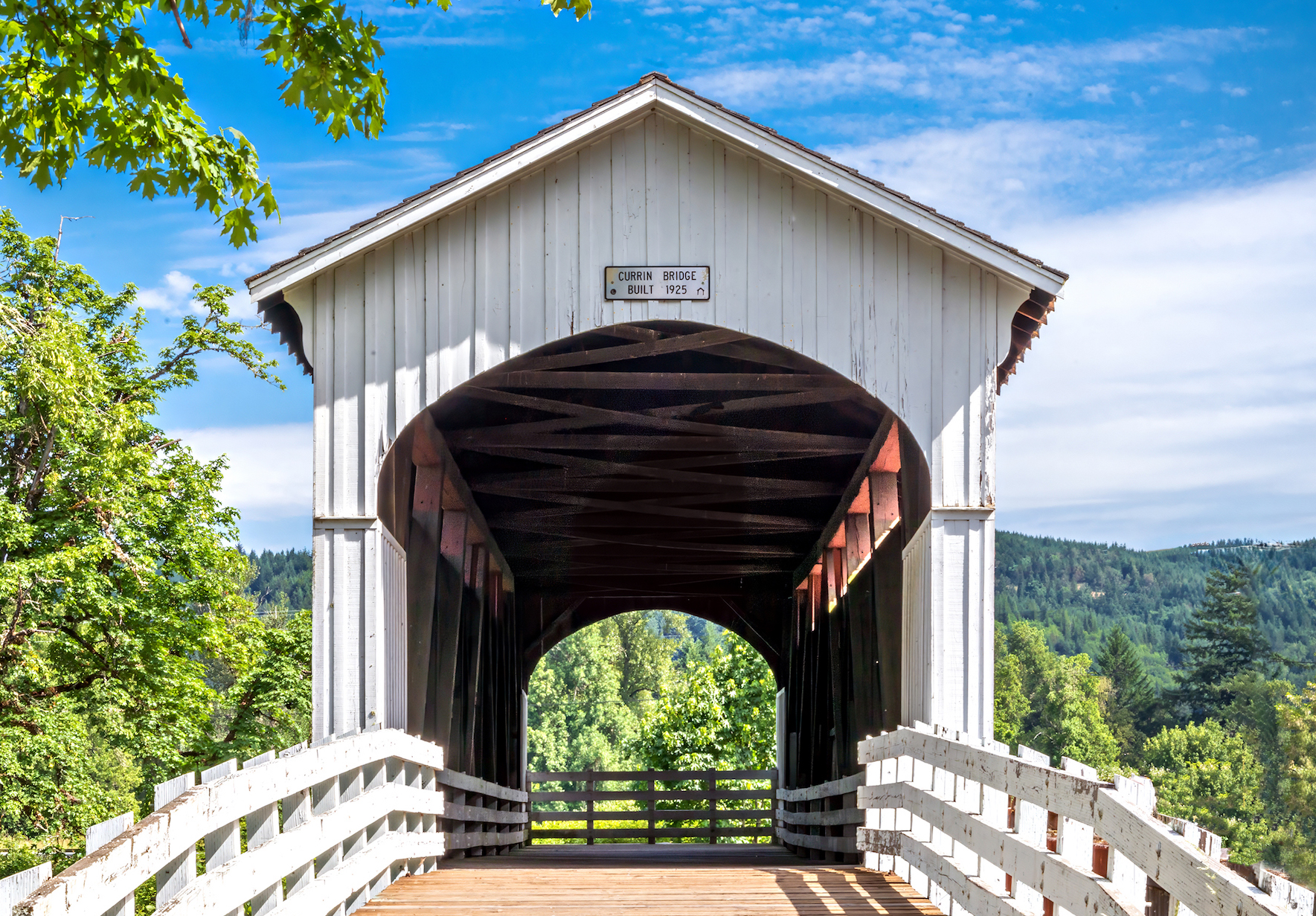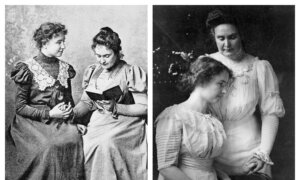There are few spans with the allure and lore of covered bridges. Most of us associate them with New England, and with Iowa since the 1995 movie “The Bridges of Madison County.” Few people associate them with Oregon, or more to the point, Lane County. There are 54 preserved wooden covered bridges in Oregon—the largest number of any state west of the Mississippi River—and 20 of them are in the one county.
The romantic appeal of covered bridges is a modern phenomenon. The often-pastoral single spans transport city dwellers to a bygone era when the community structures were authentic works of art and craft.
Beyond the Imagination
Rugged pioneers armed with only hand tools began building covered bridges in Oregon during the mid-1800s. The heyday was between 1905 and 1925, when there were an estimated 450 in the Beaver State. The abundance of Douglas fir in the Northwest and the shortage of steel during the world wars ensured the continued construction of the bridges into the 1950s.
Wooden bridges were covered to keep the huge truss timbers dry. The structures could last 80 years or more, while exposed spans deteriorated in about a decade. The covered bridge design was abandoned with the increased availability of steel trusses, which didn’t need protection from the elements, and with increased traffic, as motorists didn’t want to wait their turn to use a single lane bridge.
Beyond their status as quaint relics of the horse-and-buggy days, these civil engineering feats helped forge the economic growth of the United States for more than a century. About 14,000 covered bridges spanned the national landscape during that time. Today, roughly 750 remain.
Historic Town and Tour
The Willamette Valley cradles Lane County’s charming collection of covered bridges. In spring, lambs, calves, and foals frolic in the wildflower strewn green fields surrounding many of the bridges. During summer, they are for swinging on ropes above swimming holes, and a shady respite from the heat of the day. By fall, farmyards with plump orange pumpkins and vineyards with ripe purple grapes brighten the roadways, and brilliant, burnished foliage frames the covered structures. In winter, veiled with snow and draped with icicles, they are reminiscent of a Currier and Ives rendition, awaiting the approach of a couple, bundled in a blanket against the cold, riding in a one-horse sleigh.
Walk inside one of the remaining bridges, and you'll find a creaky chamber that with age has become weak and brittle, where it once had strong and supple beams that bore the burden of heavy harvest wagons. Among the latticed rafters, the melody of wheels and hooves settled with songbirds in simpler days before muscular engines.
Lane County’s Cottage Grove, known as the “Covered Bridge Capital of the West,” offers six preserved covered bridges for the romantic, the historian, and the adventurer to explore. It’s a robust former Gold Rush town of 10,000 people, located about 20 miles from Eugene. The area has served as a set for hit movies including “The General,” “Animal House,” and “Stand By Me.”
The 20-mile Cottage Grove Covered Bridge Tour route loops through town and around Dorena Lake. It’s the most easily accessible way to see some of the region’s most significant Howe truss-style structures on the National Register of Historic Places. The Centennial Covered Bridge was built to commemorate the 100th anniversary of Cottage Grove’s incorporation in 1887. Comprising old timber from two demolished covered bridges, the footbridge extends 84 feet across the Coast Fork Willamette River in Veterans Park.

Centennial Bridge in Veterans Park in Cottage Grove, Ore. (Maria Coulson)
Across town is the only remaining covered railroad bridge in Oregon, built by lumberman J.H. Chambers in 1925 for logging trains. The pedestrian bridge’s sweet-smelling redwood sides reach much higher than highway-covered spans, and make it look much longer than 84-feet. The bridge fell into disrepair after the railroad closed in 1951. It was rebuilt in 2011.
On the park side of the Chambers Covered Bridge is the wrought-iron design of a steam locomotive that gives the illusion it just chugged through the structure. The railroad motif extends inside with the stainless steel silhouette of a steam engine on the wall and railroad tracks embedded in the floor. “Standing inside the bridge,” an enthralled Boothbay, Maine, train enthusiast said, “you can almost imagine a huge locomotive coughing steam in those days gone bye.”

The interior of Chambers Covered Bridge, one of the covered bridges in Cottage Grove, Ore. (Maria Coulson)

A wrought iron steam engine in front of Chambers Bridge in Cottage Grove, Ore. (Maria Coulson)
Covered in the Country
The tour quickly takes you from the bustling burg to the tranquil countryside. The Mosby Creek Covered Bridge is the only one that is still part of Cottage Grove’s roadway infrastructure. Built in 1929, it extends 90 feet and is open to traffic. Similar to two other bridges on the tour, it has semi-circular portal arches, ribbon openings at the eves, and board-and-batten cladding exterior.

Mosby Creek Bridge, the only covered bridge that is still part of Cottage Grove's roadway infrastructure. (Maria Coulson)
Built in 1930, the Stewart Covered Bridge was used by vehicles to cross Mosby Creek until 1987. In need of repair, it’s now closed off. Two knotted ropes dangle beneath the bridge over what is considered one of the best swimming holes in Lane County.

Stewart Bridge in Cottage Grove, Ore., sits over what is considered to be one of the best swimming holes in Lane County. (Maria Coulson)
Vehicles can still cross the 105-foot-long Dorena Covered Bridge, constructed in 1949 and rehabilitated in 1996. The road now ends at the bridge located at the base of Dorena Lake—a picturesque spot for weddings.

Dorena Bridge is now located at the edge of Dorena Lake, Ore. (Maria Coulson)

Interior of Dorena Bridge near Dorena Lake, Ore. (Maria Coulson)
The tour route runs through thick stands of trees and skirts the shore of the large lake to the last stop. The Currin Covered Bridge is most notable for its quirky, old barn look—red on the sides, white on the front and back, with a corrugated metal roof. It was built in 1883, replaced in 1925, and closed to traffic in 1979. The 105-foot span over the Row River has since been restored and opened to pedestrians.

Currin Bridge is notable for its quirky barn appearance. (Maria Coulson)
Oregon recognized the intrinsic value of its wooden covered bridges by passing legislation 46 years ago to help preserve these rich links to its heritage. Private organizations, such as the National Society for the Preservation of Covered Bridges, celebrate them as a national treasure and are committed to conserving their cultural legacy and structural integrity for future generations.























